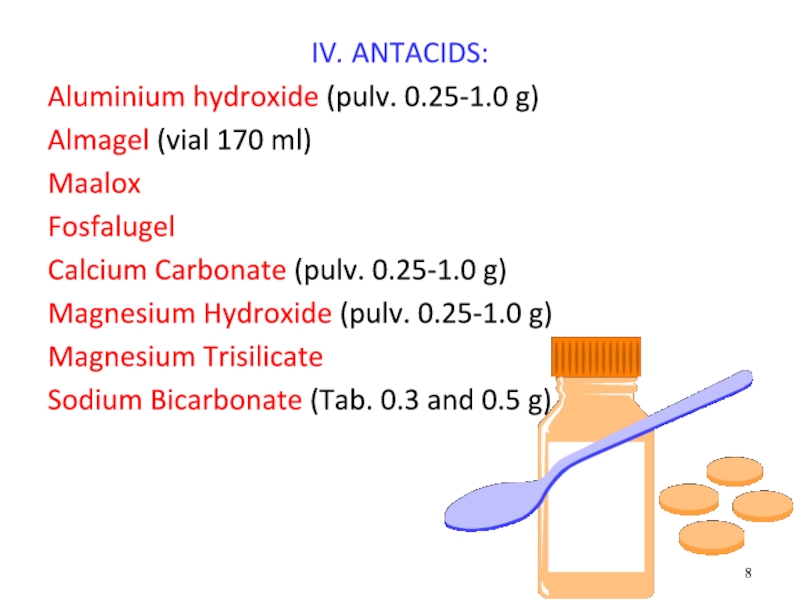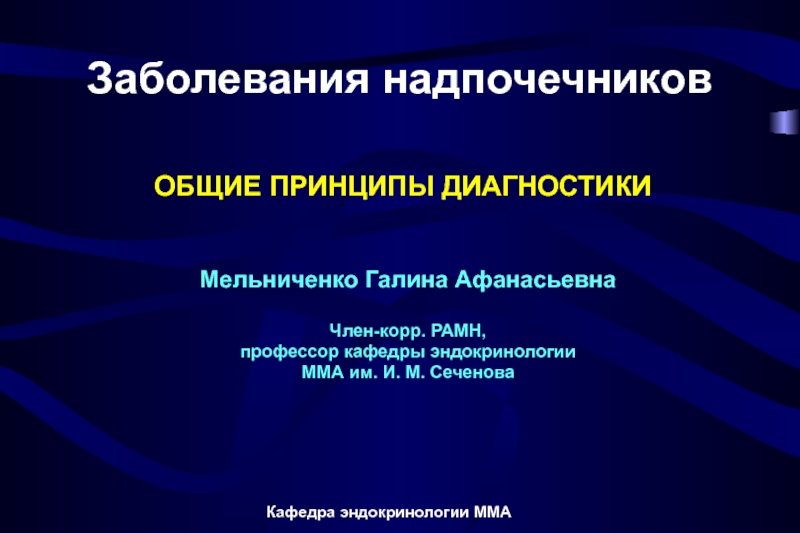Drugs Used to treat Gastrointestinal Diseases
- Главная
- Разное
- Дизайн
- Бизнес и предпринимательство
- Аналитика
- Образование
- Развлечения
- Красота и здоровье
- Финансы
- Государство
- Путешествия
- Спорт
- Недвижимость
- Армия
- Графика
- Культурология
- Еда и кулинария
- Лингвистика
- Английский язык
- Астрономия
- Алгебра
- Биология
- География
- Детские презентации
- Информатика
- История
- Литература
- Маркетинг
- Математика
- Медицина
- Менеджмент
- Музыка
- МХК
- Немецкий язык
- ОБЖ
- Обществознание
- Окружающий мир
- Педагогика
- Русский язык
- Технология
- Физика
- Философия
- Химия
- Шаблоны, картинки для презентаций
- Экология
- Экономика
- Юриспруденция
Drugs used to treat gastrointestinal diseases презентация
Содержание
- 1. Drugs used to treat gastrointestinal diseases
- 2. Agents Stimulating the Appetite: 1. Bitters:
- 3. Wormwood tincture contains glycoside Absinthian and Ethereal
- 4. Agents Inhibiting Appetite Appetite Suppressants
- 5. Drugs Used to Treat Peptic Ulcer Disease
- 6. II. Gastroprotectors: 1. Producing Mechanical Defense of
- 8. IV. ANTACIDS: Aluminium hydroxide (pulv. 0.25-1.0 g)
- 9. V. Myogenic Spasmolytics: No-spa – amp. 2%
- 10. H2-antagonists Cimetidine, Ranitidine, Famotidine - inhibit (by
- 11. Cimetidine has Endocrine effects and acts as
- 12. OMEPRAZOLE is the prototype of substituted benzimidazoles,
- 13. Prostaglandins E1 and E2 : ↓HCL and
- 14. ANTACIDS are weak bases that react with
- 15. Emetic Agents - are the drugs that
- 16. Antiemetic Agents Metoclopramide – Tab. 5 mg,
- 17. Corticosteroids: Dexamethasone Methylprednisolone
- 18. ANTIDIARRHEALS Loperamide - is widely used to
- 19. Classification of Cholagogic Agents I. Agents
- 20. Cholosas (vial 300 g) is a syrup
- 21. Hepatoprotectors Lipoic Acid [Thioctic acid]: Tab. 12
- 22. Agents Used in Disturbances of the Excretory
- 23. 2. Inhibitors of the Proteolytic Enzymes of
- 24. Orlistat is a pancreatic Lipase inhibitor,
- 25. LAXATIVES I. Irritant Laxatives – Purgatives,
- 26. CASTOR OIL (Oleum Ricini) a small bowel
- 27. LARGE BOWEL IRRITANT PURGATIVE Drugs containing
- 28. Bisacodyl (tab. 5 mg; rectal supp. 10
- 29. Thank You for Attention !
Слайд 1 Zaporozhye State Medical University Pharmacology and Medical Formulation Department Lecture №
Слайд 2Agents Stimulating the Appetite:
1. Bitters: Wormwood tincture –
Tinctura Absinthii -
PO 15-20 drops 15-20 min before meals tid
2. Others: Insulin, Vitamins,
Anabolic Steroids: Retabolil
Phenoboline
Слайд 3Wormwood tincture contains glycoside Absinthian and Ethereal Oil composed of Terpenes
Bitters stimulate receptors of oral cavity mucous and increase
the excitability of Starvation’s Center located
at Lateral Nucleus of Hypothalamus.
Слайд 4
Agents Inhibiting Appetite
Appetite Suppressants – Anorexigenic agents:
1. Centrally acting adrenergic
Phenamine (Amphetamine)
Phepranone (dr. 0.025 g)
2. Centrally acting serotoninergic agonist:
Fluoxetine (Prozac – tab. 0.02 g)
3. Centrally acting agents on both adrenergic and serotoninergic systems – depressing the CNS:
Sibutramine (caps. 5 and 10 mg)
Слайд 5Drugs Used to Treat Peptic Ulcer Disease
I. Inhibitors of Gastric Acid
1. Proton Pump Inhibitors:
Omeprazole (caps. 0.02 g)
Lansoprazole (caps. 0.03 g)
Pantoprazole (tab. 0.04 g)
Rabeprazole (tab. 0.01 and 0.02 g)
2. H2-Histamine Receptor Blockers:
Cimetidine (amp. 10%-2 ml, tab. 0.2 g)
Famotidine (tab. 0.02 and 0.04 g)
Ranitidine (tab. 0.15 g)
3. M-Cholinoblockers:
Atropine sulfate (amp. 0.1%-1 ml, tab 0.5 mg)
Platyphyllin hydrotartrate (amp. 0.2%-1 ml, tab. 0.005 g)
Pirenzepine (Gastrozepin – tab. 0.025 and 0.05 g)
Слайд 6II. Gastroprotectors:
1. Producing Mechanical Defense of Mucous Coat:
Sucralfate (Venter – tab.
Bismuth tripotassium dicitrate (De-nol - tab. 0.12 g)
2. Increasing Protective Function of the Mucus Barrier :
● PG analogues:
Misoprostol (PG E1 – tab. 0.2 mg)
Enprostil (PG E2 – caps. 35 mg)
Arbaprostil, Rioprostil
● Others: Carbenoxolone (Biogastrone – tab. 150 mg)
Dalargin (amp. 0.001 g)
III. Antimicrobial Agents – Suppressing Helicobacter pylori - infection:
Amoxicilline (tab. 0.25 and 0.5 g)
Clarithromycin (tab. 0.5 g)
Metronidazole , Tetracycline
Слайд 8IV. ANTACIDS:
Aluminium hydroxide (pulv. 0.25-1.0 g)
Almagel (vial 170 ml)
Maalox
Fosfalugel
Calcium Carbonate (pulv.
Magnesium Hydroxide (pulv. 0.25-1.0 g)
Magnesium Trisilicate
Sodium Bicarbonate (Tab. 0.3 and 0.5 g)
Слайд 9V. Myogenic Spasmolytics:
No-spa – amp. 2% solution -2 ml,
Tab. 0.04
Papaverine hydrochloride –
amp. 2% solution - 2 ml,
Tab. 0.04 g (40 mg)
VI. Others:
Solcoseryl (amp. 2, 5 and 10 ml; vial 250 ml)
Слайд 10H2-antagonists Cimetidine, Ranitidine, Famotidine -
inhibit (by 90%) basal, food-stimulated, and
nocturnal
They block H2-receptors in the stomach, blood vessels, and other sites.
They are Competitive Antagonists of Histamine and
are fully reversible.
H2-antagonists distribute widely throughout the body (including in breast milk and across the placenta) and
are excreted mainly in the urine.
Clinical Uses: Peptic Ulcers, Zollinger-Ellison Syndrome, Gastroesophageal Reflux Disease (heartburn)
Слайд 11Cimetidine has Endocrine effects and acts as
a Nonsteroidal Antiandrogen
Endocrine effects:
Gynecomastia - abnormal overdevelopment of the breasts in a man
Galactorrhea - continuous release of milk
Impotence, Libido decrease, Reduced sperm count.
Cimetidine inhibits CYP-450 => Slows Metabolism => Potentiates the Action of some drugs:
Warfarin
Diazepam
Phenytoin
Quinidine
Carbamazepine
Theophylline
Imipramine
Слайд 12OMEPRAZOLE is the prototype of substituted benzimidazoles, which inhibit the final
Mechanism of Action: Irreversible Inhibition of
the H+/K+-ATPase (the Proton Pump) suppressing
secretion of H+ ions into the gastric lumen - the final step in the secretion of gastric acid.
It markedly inhibits both basal and stimulated gastric acid
secretion.
A singly daily dose Inhibits 100% of
Gastric Acid secretion
Слайд 13Prostaglandins E1 and E2 :
↓HCL and Gastric Acid Secretion
↑Secretion of mucus
- CYTOPROTECTIVE EFFECT
MISOPROSTOL – a stable analog of PG E1
- is approved for prevention of gastric ulcers
induced by NSAIDs
Слайд 14ANTACIDS are weak bases that react with gastric acid to form
Since PEPSIN is inactive at pH > 4.0,
Antacids also ?PEPTIC ACTIVITY.
They ⇓ Helicovacter Pylori Colonization and
⇑ PGs synthesis.
Bismuth subnitrate [Tab. «Vicairum», «Vicalinum»]
De-nol [Bismuth tripotassium dicitrate – Tab. 0.12 g]
Aluminum hydroxide [pulv. 0.25-1.0 g]
Magnesium hydroxide [ pulv. 0.25-1.0 g]
Almagel [vial 170 ml]
Maalox [suspension 250 ml, chewable tab.]
Sodium bicarbonate [Tab. 0.3 and 0.5 g]
Calcium carbonate [pulv. 0.25-1.0 g]
Слайд 15Emetic Agents - are the drugs that produce vomiting. They may
1. Centrally acting, by stimulation of the CTZ:
Apomorphine hydrochloride (amp. 1%-1 ml) -
a semisynthetic derivative of Morphine.
It stimulates D2-receptors of the trigger zone.
Injected SC, it causes vomiting within 5 minutes
2. Peripherally acting: stimulate the vomiting center reflexively:
Preparations from Thermopsis and Ipecacuanha
Copper Sulfate and Zinc Sulfate have peripheral action
through irritation of stomach mucosa.
Emesis has a reflexive character after their introduction, however they are not used to produce vomiting.
Слайд 16Antiemetic Agents
Metoclopramide – Tab. 5 mg, amp. 0.5%-2 ml
inhibits D2
in high dose blocks 5-HT3-receptors to inhibit or reduce
nausea and vomiting.
Domperidone (Motilium) – Tab. 10 mg
- inhibits D2 receptors.
Advantage of Domperidone is its no penetrating blood-brain barrier and no-inducing Extrapyramidal Effects.
Clinical Uses:
Functional disorders of the GIT,
Stomach hypotonia, Reflux-esophagitis.
Слайд 17Corticosteroids: Dexamethasone
Methylprednisolone
are effective against Emetogenic Chemotherapy.
Their antiemetic mechanism may involve blockade of PGs.
The antagonists of the Serotonin Receptors:
Ondansetron (amp. 0.2%- 2 and 4 ml, tab. 4 and 8 mg)
Tropisetron -
selectively block 5-HT3 receptors:
⮚ In the periphery (visceral afferent fibers) and
⮚ In the brain (CTZ).
Ondansetron is approved for prevention of postoperative nausea and/or vomiting.
Слайд 18ANTIDIARRHEALS
Loperamide - is widely used to control acute and chronic diarrhea.
It is phenylpiperidine derivative and has Opioid-like actions on the gut:
Activates Presynaptic Opioid Receptors
in the enteric NS to inhibit Acetylcholine Release and decrease peristalsis.
Side effects: drowsiness, abdominal cramps, dizziness,
Toxic Megacolon => they should not be used in young children or patients with severe colitis.
Слайд 19Classification of Cholagogic Agents
I. Agents Stimulating Bile Formation:
1. Agents Containing
2. Synthetic agents: Oxaphenamide (tab. 0.25 g)
3. Plant drugs: Cholosas (vial 300 ml)
II. Agents Stimulating Bile Migration:
1. Cholekinetic agents (increasing the Bile Tone):
Magnesium Sulfate, Sorbitol, Berberis
2. Cholespasmolytic agents –
Decreasing the Biliary Tract and Sphincter Oddi tone:
• Spasmolytics: Papaverine, No-spa, Euphyllin, Magnesium Sulfate
• M-cholinoblockers: Platyphyllin hydrotartrate
All cholagogic agents increase bile production by hepatic cells.
Слайд 20Cholosas (vial 300 g) is a syrup prepared from
condensed rosehip
It is a dark brown syrup-like liquid the sour-sweet to taste.
Cholosas has choleretic action and stimulates bile formation.
Ripened Rose berries have a lot of minerals (K, Ca, Mg, P, Fe, Cu, Mn, Cr, Mo, Co) and vitamins ( B1, B2, B6, K, E, PP, C) tanning agents, carotin, riboflavin, citric and apple acids, phytoncides, essential oils.
Rosehip berries contain 5-10 times > of vitamin C than black currants
and 40 times > than a lemon.
Water extraction methods allow to concentrate and preserve maximum
of biologically active substances and
the extract is more potent than raw berries.
Clinical uses:
cholecystitis, hepatitis, anemia, scurvy,
kidney and bladder diseases.
Слайд 21Hepatoprotectors
Lipoic Acid [Thioctic acid]: Tab. 12 mg, amp. 0.5% - 2
Legalon (Silymarin): Dr. 70 mg, Caps.140mg
- contains Extract from dry Lady's-milk (Silybum marianum) and its flavonoids Silymarin and Silybinin.
Hepabene: 1 capsule contains 100 mg of Lady's-milk extract and 275 mg of Fumitory (Fumaria officinalis) extract.
=> Cholagogic, Hepatoprotector and
Spasmolytic actions.
Methionine (essential amino acid)
PO 0.5 - 1.0 g 3-4 times / day
Clinical Uses:: Dyskinesia of Biliary Tracts,
Toxic Liver Lesion, Alcoholism,
Chronic Liver Diseases, Liver Cirrhosis.
Слайд 22Agents Used in Disturbances of
the Excretory Function of Pancreas
I. For
Pancreatin (Creon) contains Pancreatic Enzymes
Amylase, Protease, Lipase –
is extracted from Fresh Hog Pancreas.
Preparations containing Pancreatin:
Digestal
Mezym-forte
Festal
Panzynorm
Слайд 232. Inhibitors of the Proteolytic Enzymes of Pancreas
- are used
CONTRICAL (Trasylol, Aprotinin) – vial 30 000 KIU/ml
naturally occurring protease inhibitor.
It inhibits Trypsin, Plasmin,
and plasma and tissue Kallikreins.
Inhibits Fibrinolysis through
inhibition of Plasmin and Kallikreins.
Inhibits activation of the Intrinsic Clotting System,
a process that initiates coagulation and promotes fibrinolysis.
Слайд 24
Orlistat is a pancreatic Lipase inhibitor,
preventing the breakdown of dietary
fatty acids and glycerols.
It causes a dose-related increase in fecal fat that
plateaus at 32% of dietary fat.
Слайд 25LAXATIVES
I. Irritant Laxatives – Purgatives, Cathartics
1. Small Bowel Irritant Purgative:
Vegetable
2. Large Bowel Irritant Purgative:
⮚ Drugs containing Antraglycosides:
Radix Rhei, Cortex Frangulae Alni, Folia Sennae
⮚ Synthetic agents:
Phenolphthaleine, Isaphenine, BISACODYL
II. Osmotically Active Laxatives –
Agents acting on all Bowel Sections (Bulk Laxatives):
Salt laxatives: MgSO4 ; Na2SO4
Слайд 26CASTOR OIL (Oleum Ricini) a small bowel irritant, is a colourless
the seeds of the plant Ricinus communis and used as a cathartic and a fine lubricant.
When ingested, it is hydrolized in
the intestine by pancreatic lipase
to glycerol and ricinoleic acid.
Ricinoleic acid acts as an irritant and
produces purgation.
As ricinoleic acid acts on the small intestine,
It produces copious, liquid stools, with fluid loss.
It may stimulate uterine contraction in pregnant women.
It can be employed after oral ingestion of a toxin to hasten elimination
and to reduce absorption of toxin from the gut.
CASTOR OIL is not indicated after the ingestion of lipophilic toxins likely
to depend on bile acids for their absorption.
Слайд 27LARGE BOWEL IRRITANT PURGATIVE
Drugs containing ANTRAGLYCOSIDES are
of plant origin:
Folia Sennae
Ffructus
of the Senna plant
Cortex Frangulae – of the bark of Buckthorn
Rhizoma Rhei - the roots of RHUBARB
the Leaf Extract from Aloe Species.
Following ingestion of galenical preparations or of the anthraglycosides, discharge of soft stool occurs after a latency of 6 - 8 h.
The anthraquinone glycosides themselves are inactive but are converted by colon bacteria to the active free aglycones.
Слайд 28Bisacodyl (tab. 5 mg; rectal supp. 10 mg)
is rapidly converted
and gut bacteria into its active metabolite
which directly irritates and stimulates the large bowel.
Given by the enteral route, bisacodyl is subjected to hydrolysis of acetyl residues, absorption,
conjugation in the liver to Glucuronic Acid (or also to sulfate), and biliary secretion into the duodenum.
Oral administration is followed by discharge of soft formed stool after 6-8 hours.
When given in suppository, it produces its effect within 1 h.




















![HepatoprotectorsLipoic Acid [Thioctic acid]: Tab. 12 mg, amp. 0.5% - 2 mlLegalon (Silymarin): Dr. 70](/img/tmb/5/448818/0a09b277f2a97b3ec52bc8c78fbc6e9e-800x.jpg)













